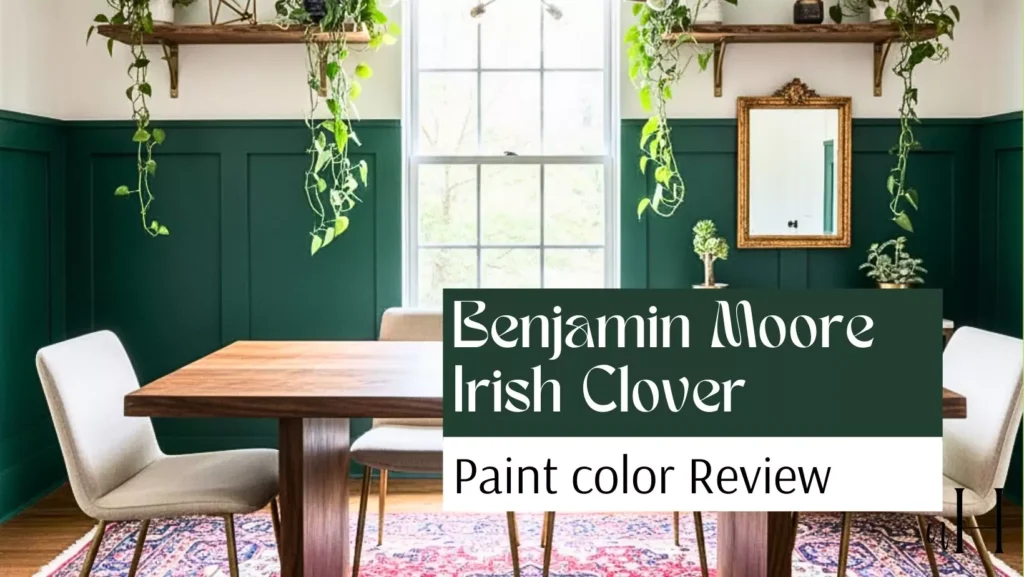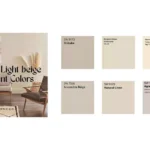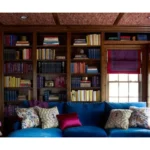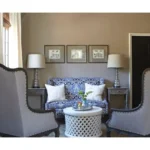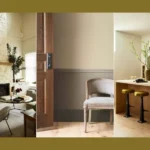Benjamin Moore’s Irish Clover (2038-20) is a rich, deep green paint.
In simple words, it’s like looking at a clover patch in the forest – very green and alive, but also quite dark. This color is not a pale or light green; it is strong and bold.
Because Irish Clover is dark, it stands out against lighter furniture or white trim. In a room, it can make everything else pop. It tends to give a space a cozy, nature-like feeling. The name “Irish Clover” hints at the lush green color of Ireland’s clovers and fields. Even though it’s dark, the “spirited” part of the name suggests it has energy.
In design, using a color like this often adds a rich, moody mood. It works well when you want a wall or cabinet to be the main star color.
As Benjamin Moore says, it “becomes the focal point in any room,” meaning people will notice it first because it’s so vivid and deep. In short, Irish Clover is a strong forest-green with a friendly feel – it’s easy to see why it is described as deep, lively, and eye-catching.
Undertones of Benjamin Moore Irish Clover

Every paint color has hidden undertones – subtle hints of other colors within it. Irish Clover has a cool tone with a blue undertone. This means if you look very closely, there’s a bit of blue mixed into the green. The blue undertone makes the color feel calm and cool.
In easy terms, imagine mixing a tiny bit of blue paint into green; it becomes a cooler shade of green. This blue hint keeps Irish Clover from looking too yellowish or warm.
In very simple words: Irish Clover is not a flat, plain green. It’s a deep green with a cool-blue cast and a lush feel. It’s like the green of fern leaves in deep shade – vivid but a bit cool. These undertones make it versatile: in sunlight it might look a bit brighter and cooler, while in warm light it might look slightly more teal. But always, it will appear as a bold, nature-inspired green with a touch of blue in it.
OTHER POPULAR GREEN COLORS
LRV of Benjamin Moore Irish Clover
LRV stands for Light Reflectance Value. This is a number that tells us how much light a color reflects. Values go from 0 (pure black, which reflects no light) to 100 (pure white, which reflects all light). Irish Clover has a very low LRV – about 15 (some sources say 15.7). In plain terms, that means it reflects only 15% of light, so 85% of light is absorbed. T
his makes it a dark, rich color. A low LRV means a color will make a room feel darker and more intimate. The official Benjamin Moore data confirms this number: its LRV is 15.72, which matches other measurements saying “nearly 15.”
For those curious: the official Benjamin Moore site even defines LRV for us. It says LRV is how designers measure light reflection, “with 100 being pure white and 0 being absolute black.” And it directly tells us that Irish Clover’s LRV is 15.72. This tells you that in a low-light or north-facing room, Irish Clover will look especially deep and intense.
In a bright south-facing room it will still feel dark, but the light will help it appear slightly livelier. Overall, its low LRV means Irish Clover adds richness and coziness, but you may want good lighting or lighter accents when using it in a space.
In Different Lights
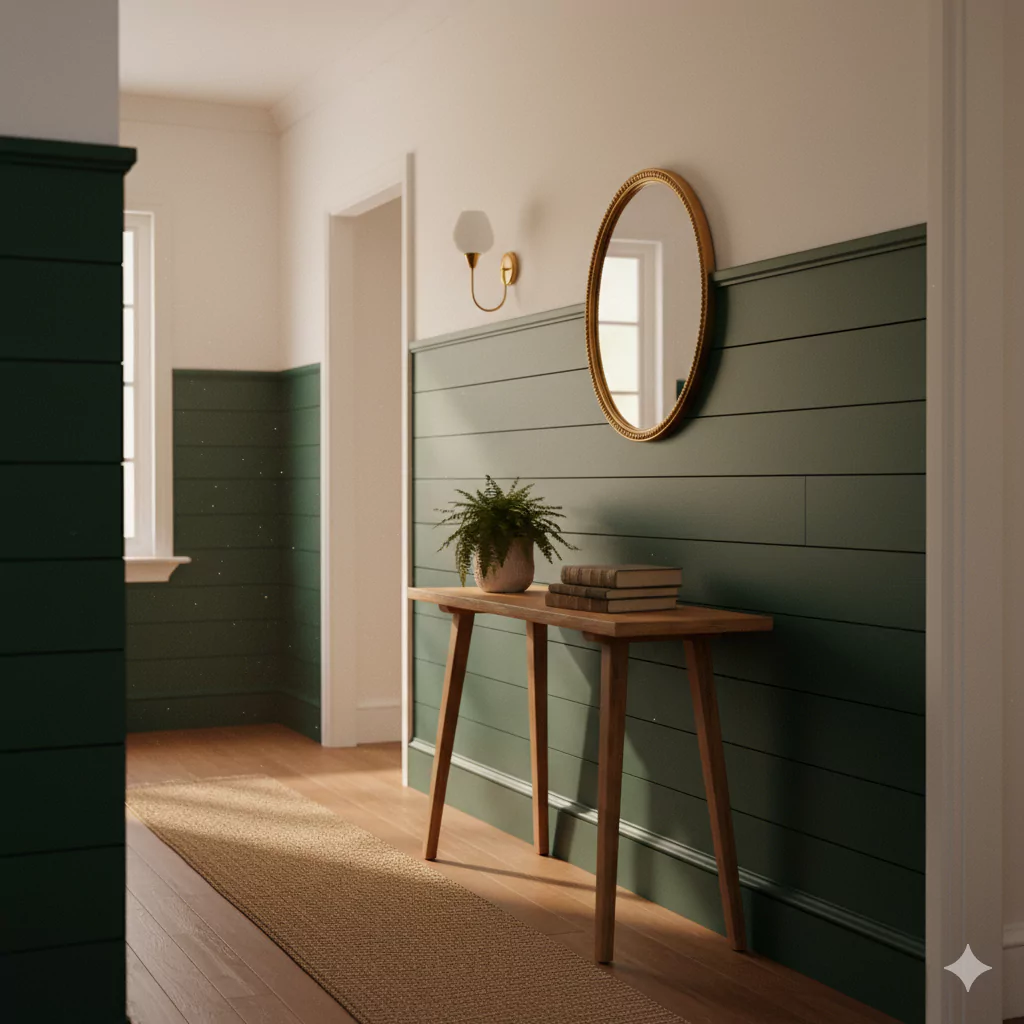
A paint’s look can change a bit depending on light. For Irish Clover, there’s no exact quote from our sources about this, but we can use the LRV info to understand. Because this green has a low LRV (around 15), it will look much darker in dim light and slightly brighter in strong light.
In simple terms, bright sunlight (or a room with lots of sunlight) will make Irish Clover show its true rich green; it may even look a bit more vibrant under sun or bright LED light. In shade or at night, it will look almost black-green or very deep forest green, because there is less light to reflect.
The blue undertone can shift slightly. In cool daylight, it might look cooler/bluer; in warm incandescent light, it might lean a tad greener. The key is that Irish Clover is always on the cool side, so it will never look yellow or warm.
Light color temperature and time of day will affect whether it looks more forest-green or more teal-green. Overall, people say it can behave like a bit of a chameleon: in different lights Irish Clover shifts in intensity. In bright light it holds its deep green color vividly; in dim light it simply looks darker and moodier.
Hex Code
Computers and web designers use a hexadecimal code to specify colors. Irish Clover’s hex code is #007C56. This code is like an address for the color: the “#” starts it, and then pairs of characters show red, green, blue levels. In this case, 00 is the red value, 7C (which is 124 in decimal) is the green value, and 56 (86 decimal) is the blue value.
You can check the code with any color tool if curious. But basically, #007C56 means no red, medium-high green, and a fair amount of blue, which together make that dark teal-green we see. Always remember that #007C56 is Irish Clover’s identifier in digital form.
RGB
Similarly, the RGB (red, green, blue) components for Irish Clover are (0, 124, 86). This is another way to say what hex says. The first number is the red part (0 – meaning absolutely none of red), the second is green (124 out of a possible 255), and the third is blue (86 out of 255). In easy words, it is a very strong green (124) with a bit of blue (86) and no red (0). This matches our eyes seeing it as a teal-green.
You can think: if you turn on the green light and some blue light (but no red), you’ll see this deep green. RGB is used in digital screens, so if you use this color in a computer program, these are the numbers you’d use.
In a Bedroom
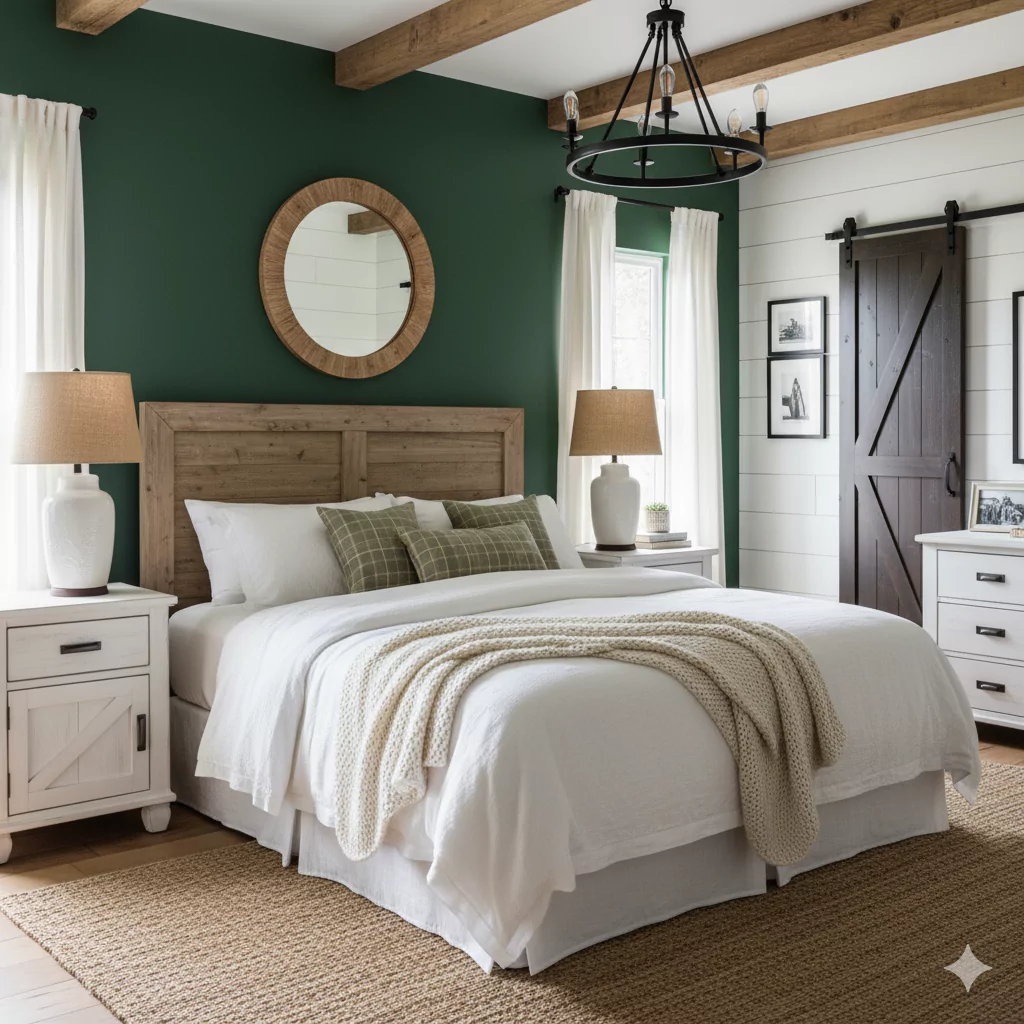
A dark green like this can create a calm, cocoon-like space. If you paint a bedroom wall or accent wall this color, it will feel cozy and restful, because greens are soothing to our eyes (they remind us of nature).
23 Dark Green Bedroom Ideas that Never Go Out of Style
For example, you might paint the wall behind the bed Irish Clover and use light-colored bedding. The deep green can make a bedroom feel like a peaceful forest retreat. Because it’s a darker color, you might use it on just one wall or on the ceiling if the room is small, to keep it from feeling too closed-in. Pairing it with whites or creams on other walls and bedding can brighten the room.
In a Kitchen
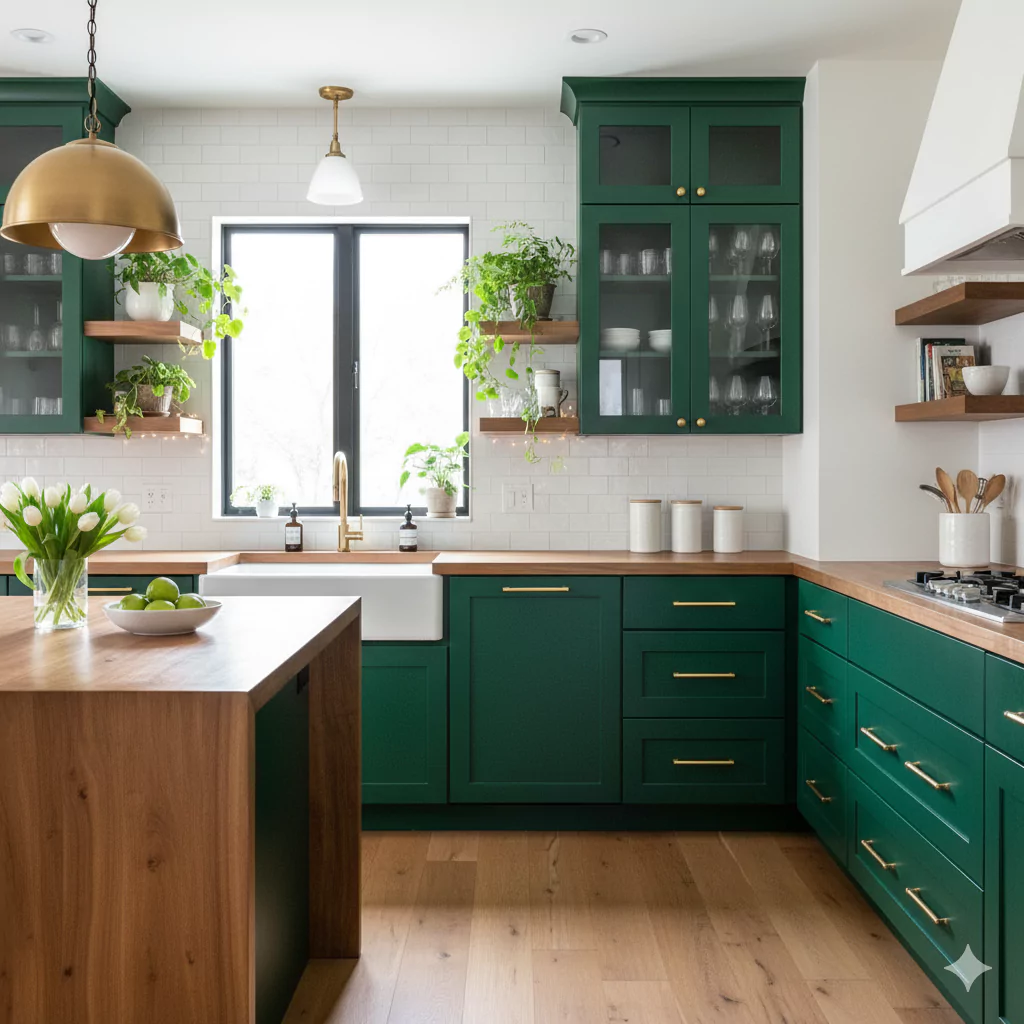
Dark greens are trendy in kitchens. For example, many people paint kitchen cabinets in deep green or forest colors. Irish Clover could be used on cabinets or an island for a bold look.
In a kitchen, Irish Clover would add warmth and depth. It pairs nicely with natural wood tones and black or stainless accents. If you paint all cabinets Irish Clover, the kitchen feels grounded and classic. If that seems too intense, use it on just the island or lower cabinets. With good lighting, it gives a cozy, inviting atmosphere.
7 Popular Green Kitchen Cabinets Countertop and Hardware Ideas
In a Living Room
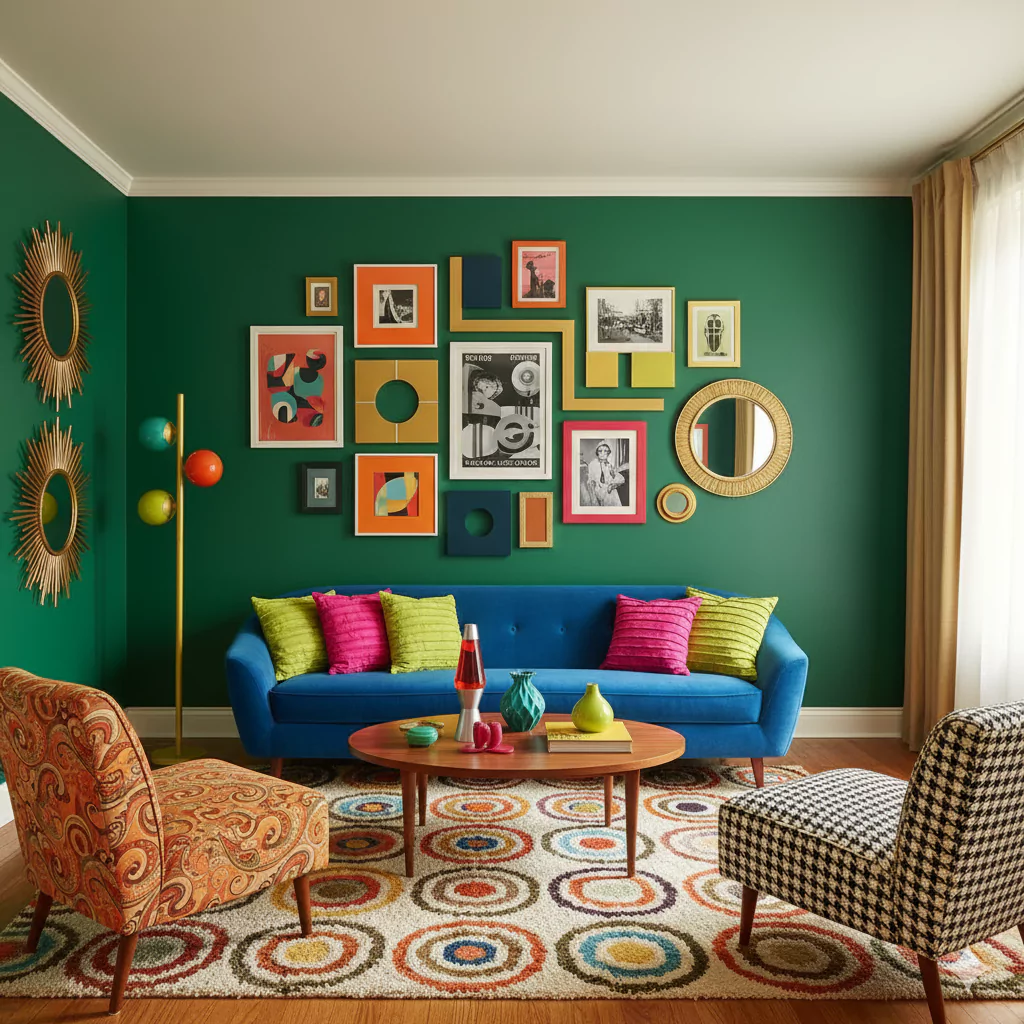
The living room is a common place to experiment with color. For Irish Clover, you could use it on all walls for a bold vibe, or just one accent wall. A style tip from Better Homes & Gardens recommends using “a single spark of color such as Benjamin Moore 2038-20 Irish Clover alongside a predictable neutral palette.”
This means you can pair it with lots of white, gray, or beige in your living room. For instance, you might paint one wall Irish Clover and keep the others white or light gray. Then white trim and light furniture will pop against the green.
In casual terms: a little Irish Clover color (like on pillows, art, or a chair) can make neutrals feel lively. If you go bolder, a whole wall of green with a white couch can feel dramatic and elegant. Using soft gold or wood tones with it adds warmth.
In a Bathroom
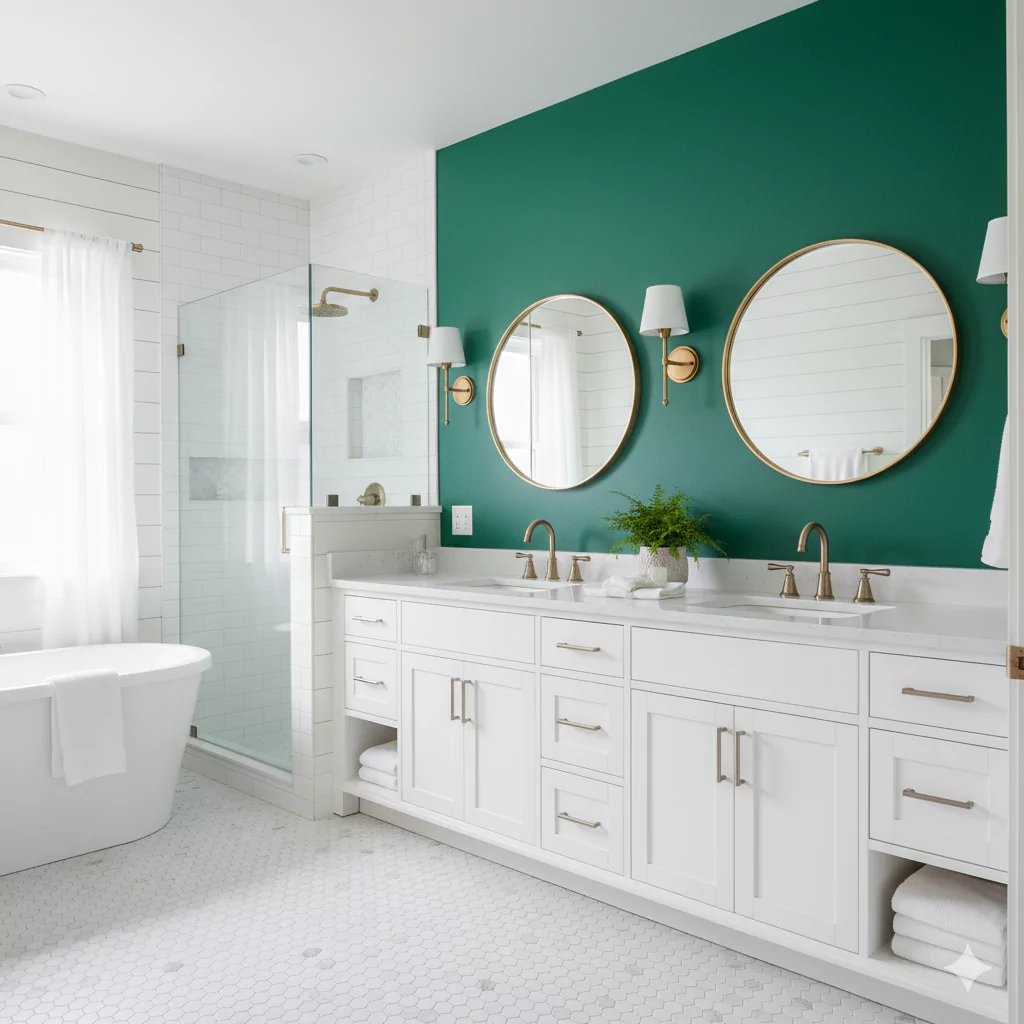
Deep green paints like Irish Clover often give a spa-like vibe in bathrooms. You might use it on the vanity cabinets or the wall behind the mirror. With lots of white tile and shiny faucets, it would make the room feel lush, as if you’re in a luxury forest spa.
If the bathroom has little natural light, just one green accent wall might be enough. Green is also known to be refreshing, so it could be energizing in the morning.
On Cabinets
Cabinetry (in kitchens or bathrooms) is very popular to paint in bold colors now. Irish Clover on cabinets would look rich and classic. You could paint the kitchen island or lower cabinets this green, while keeping upper cabinets white for contrast.
The deep color brings a natural feel, especially if you have wooden countertops or floors. Using Irish Clover on cabinets creates a statement and pairs nicely with brass or black hardware.
On the Exterior
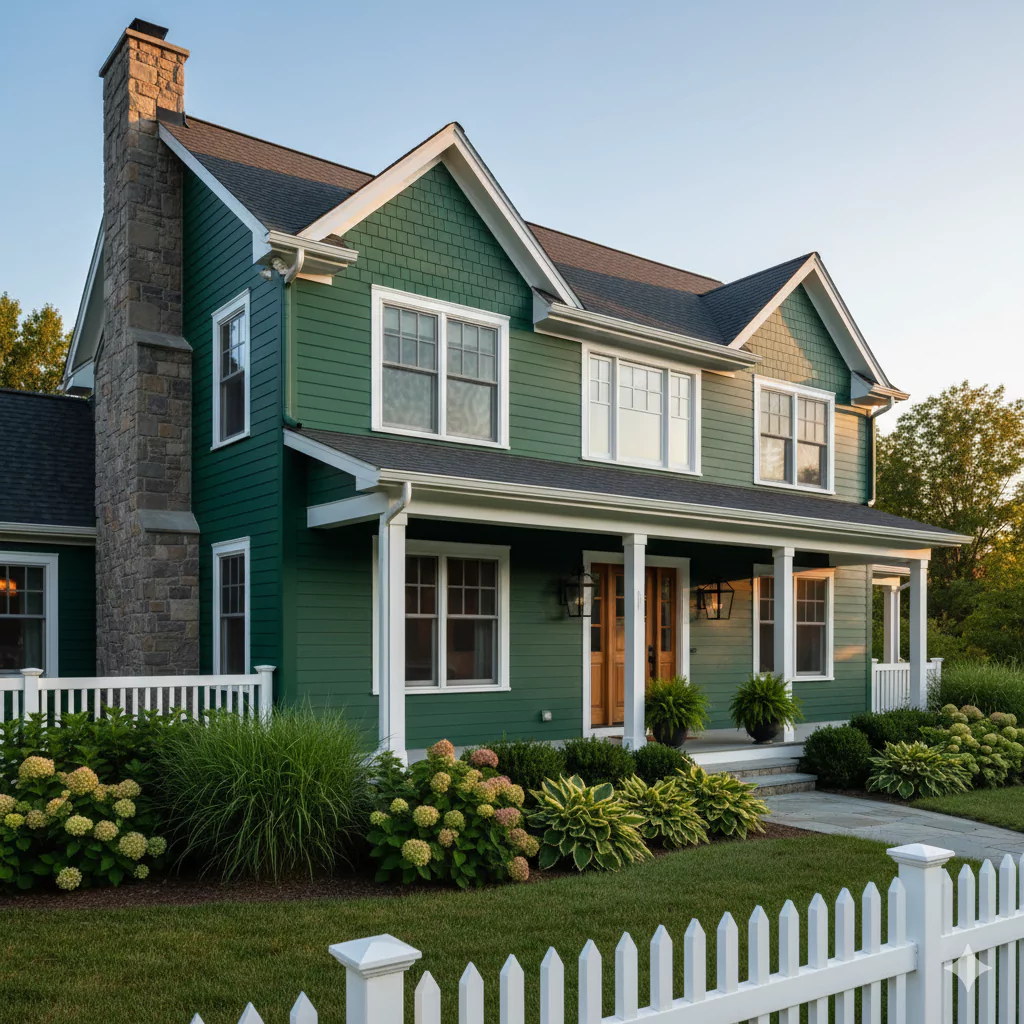
For the outside of a house, Irish Clover could be used on the front door, shutters, or even siding. A dark green front door with white trim looks very classic. If the house is in a wooded setting, green can blend well with the surroundings.
Against gray stone or white walls, Irish Clover would look striking. In general, dark rich colors like deep green can give a home a timeless, natural look.
Coordinating Colors
Good coordinating colors make Irish Clover fit into a design. Benjamin Moore itself suggests pairing Irish Clover with crisp whites and soft grays. For example:
- Snow White (OC-66) – a very clean white trim or cabinet color
- Iced Cube Silver (2121-50) – a light silvery gray for walls or accents
- Cloud White (OC-130) – a soft creamy white for walls or trim
- Morning Dew (OC-140) – a gentle off-white for a relaxed feel
These work because the bright whites and silvery grays balance the deep green, making it stand out. Another simple neutral is any warm beige or pale wood tone, which always looks nice with a green. A “predictable neutral palette” (like ivory, gray, taupe) is recommended when adding Irish Clover. Essentially, think of white or soft gray as safe partners: they let the green shine without clashing.
Soft Palette
If you want a gentle, soft palette, think pale or pastel colors alongside Irish Clover. For example, pale pinks, light blues, or soft lavender can create a calm vibe. Another approach is to mix in other soft greens: maybe a mint or sage on an adjacent wall.
Using those light pastel-like colors makes a room feel airy, with Irish Clover as an accent. Soft whites, creams, and blush tones also count as a soft palette; they give a cozy balance to the dark green.
Bold Palette
For a bold palette, pair Irish Clover with other strong colors. A complementary choice is burgundy (#7C0026). Burgundy is a deep red-violet and sits opposite green on the color wheel. Using them together is a classic Christmas or nature-inspired combo.
Another bold partner could be mustard yellow or burnt orange, which are like autumn leaves next to dark green. Deep navy blue or rich plum can also work for a sophisticated bold look. These bold accents make the room feel lively.
Muted Palette
A muted palette means using quiet, understated colors with Irish Clover. Think of soft gray-blues, gentle browns, or clay tones. For example, dusty gray, soft beige, or a pale olive would mute the scheme.
Light wood and linen fabrics make an Irish Clover room feel mature and serene. For a muted look, use colors that almost feel like neutrals: greige (gray-beige), pale sage, or stone colors. This makes the green stand out less starkly and creates a calm, cohesive feeling.
Summary
Irish Clover (2038-20) is a deep, cool green with blue hints. Its Light Reflectance Value is about 15%, so it’s a dark, rich color. Benjamin Moore describes it as vibrant and focal, and experts note it adds depth and ties a room to nature.
In practice, it pairs beautifully with whites and soft grays. For a bold look, consider burgundy or mustard accents; for a calm look, stick to creams and pastel greens. In any case, Irish Clover brings the feel of the outdoors inside, making spaces feel both cozy and lively.

